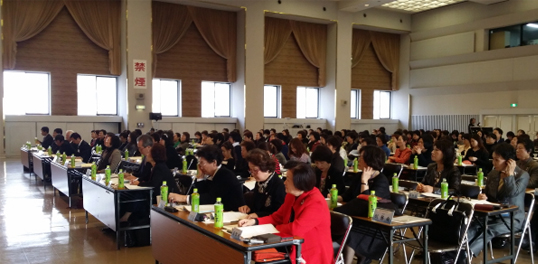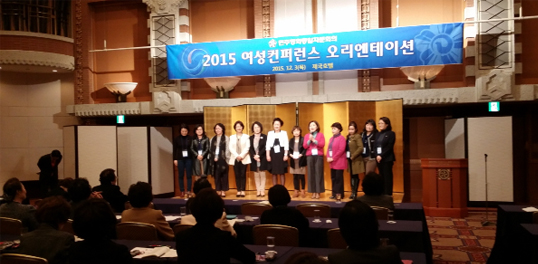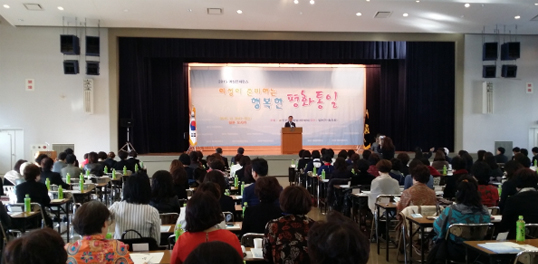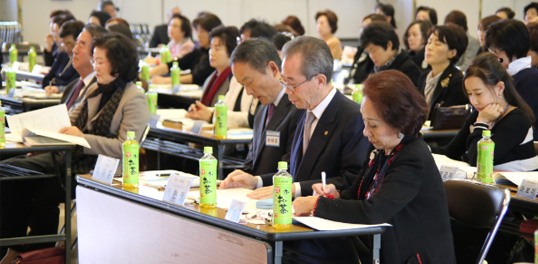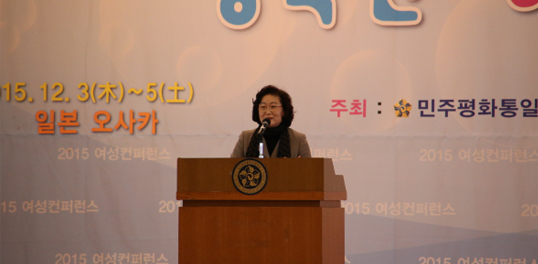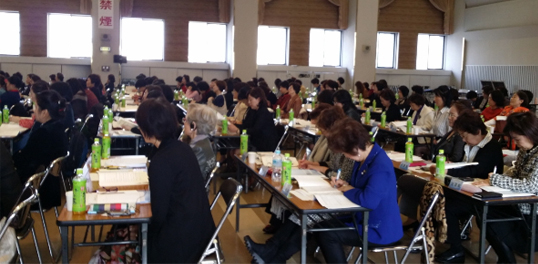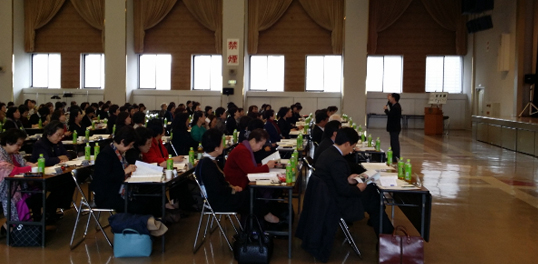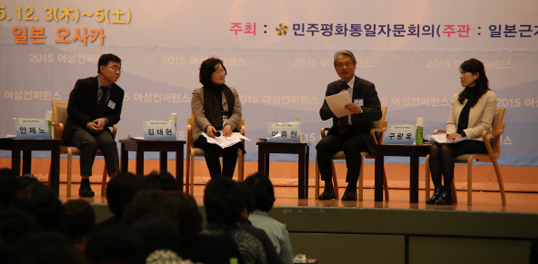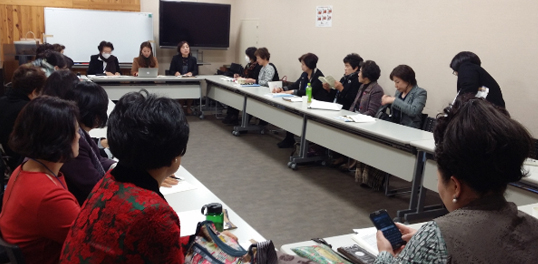| مؤتمر النساء لعام 2015 (آسيا، أوروبا، أوقيانوسيا، روسيا، الشرق الأوسط)، تم عقده في أوساكا |
|---|
| قسم الاقليم الخارجي , 2015-12-09 |
Female members from 17 cities and provinces of Asia, Europe, Oceania, Russia and Middle East attended
with “A happy and peaceful unification prepared by women” as the main topic
To create sympathy among the female members on unification policies directed at North Korea, and to establish an active network among female members and seek a direction for their activities, the 2015 Women’s Conference was held for the female members of Asia, Europe, Oceania, Middle East and Africa from December 3rd to 5th in Osaka, Japan.
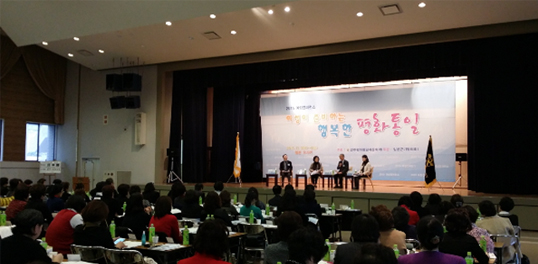
Panorama of Women's Conference
In this conference, hosted by the Japan Kinki Council, 125 female members from 18 chapters of Japan, China, Russia, Europe, Oceania and Middle East and 25 domestic female members participated in various programs with “A happy and peaceful unification prepared by women” as the main topic.
The first day started with orientation, then a group discussion and a welcome reception. The second day, on December 4th, started with an opening ceremony, then a keynote speech by the female Vice-chairperson, Kim Tae-hyun, and special lectures by researcher Ahn Je-noh at the Institute for National Security Strategy. Lectures by Korean lawyer Koo Ryang-ok, who lives in Japan, and professor Lee Jong-won at Waseda University followed. The day continued with talks on unification and group discussions. On the last day, each group presented their discussion results and a general review followed.
[Day 1: December 3 (Thurs.)]
On the first day, all of the members gathered at the Imperial Hotel in Osaka to attend the orientation. They received an explanation of the overall program, greeted each other and expressed their expectations by revealing how they felt about the conference.
Next, the first discussion was held on the conference topic through group discussions and the first day’s program ended with welcome reception hosted by the Secretary General.
[Day 2, December 4 (Mon.)]
On the second day at 9 a.m. on December 4th, the opening ceremony was held at the Grand Hall on the 5th floor of the Osaka headquarters of Korean Residents Union to formally initiate the program.
Kwon Oh-il, the Chairperson of Japan Kinki Council, said that, “I am so proud of holding this conference with the female members of many countries here in Osaka, where overseas Korean communities started, and at Osaka headquarters of Korean Residents Union, which was developed by the dedication of our seniors and colleagues.”
He revealed his expectations of the conference as a starting point withcommunication among female members from different countries, re-considering unification policies toward North Korea and activating unification activities of women in brother societies.
Oh Gong-tae, the Vice-chairperson of Japan branch, commented, “Because Koreans living in Japan are related with Jochongnyeon (the pro-North Korean residents’ league in Japan), they are more desperate for a democratic and peaceful unification than any other groups,” and asked for greater cooperation of the Korean residents in Japan.
Ha Tae-yoon, the Consul General of Osaka, showed his expectations of the conference by adding, “I hope that the Korean residents in Japan would give constructive and creative proposals for unification activities in this conference.”
Next, Shin Eun-sook, the director of the Council Member Activities Bureau, said “We are in a better position than Germany, which has accomplished unification before us, in that we have overseas Koreans all over the world and council members representing them.” She went on to ask for the female members’ contribution by adding, “I believe that the passion and efforts of the council members, especially those of female members, all over the world will make a huge contribution to our unification.”
Then, Jung Hyun-gwon, Osaka headquarters of Korean Residents Union, stressed his opinions that, “Peaceful unification is an answer, and the only one to solve the two Koreas’ problems. We should put our heads together to unify in this generation.”
Next, a keynote speech by Kim Tae-hyun, the female Vice-chairperson, took place. She delivered her lecture with an emphasis on the reasons and methods of unification from women’s perspectives.
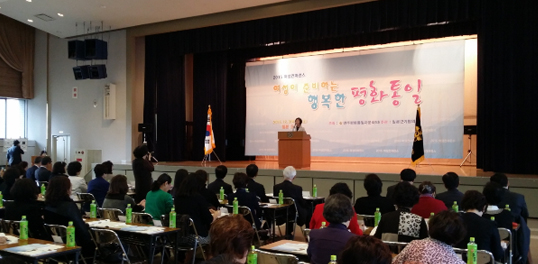
Kim Tae-hyun, the female Vice-chairperson, Delivering the Keynote Speech
Female Vice-chairperson Kim suggested a solution to the decline of labor productivity due to a low birth rate and aging, and a win-win result for both South and North Koreas, as reasons for unification. She added that President Park Geun-hye’s strong will and leadership for unification serve as a foundation for national unification.
She went on to emphasize that, “We women should prepare for unification with women’s unique strength, open-mindedness and tolerance.” She stressed her points by saying that women should be open to the North Korean culture, which has been separated from the South for the past 70 years. She also proposed that women should work on to finding unification methods considering women’s unique characteristics; pregnancy, childbirth and infant care.
At last, she stressed the importance of women’s networks for preparation in unification and expressed her expectations by speaking in confidence that this conference would be a chance to broaden the prospects worldwide with Korean women’s network.
The next step was a lecture titled, “Unification·Anti-North Korea Policy and Women’s Roles” by researcher Ahn Je-noh from the Institute for National Security Strategy.
Ahn explained that our unification plan is “Ethnic Community Unification Plan” and reminded the principles are autonomy, peace, and democracy. He continued to explain that the key point of the national affairs of Park Geun-hye’s government is by “Constructing Bases for Peaceful Unification” and emphasized the three strategies as being “Firm security, happy unification and trustworthy diplomacy.” In the short term, the government will carry out the policy of “Trust-building Process on the Korean Peninsula” in order to achieve the long-term policies on unification.
Ahn asked for female members to understand and support government policies and take a leading role in creating a ‘unification culture.’
Attorney Koo Ryang-ok, who works in Japan, explained her aspirations to becoming a lawyer while growing up as a Korean living in Japan. She explained in detail the discrimination, violence and abuse (e.g., Attack the Chima-jeogori) she experienced growing up in Japan. She received an overwhelming applause when she finished her inspiring speech.
She also described in detail how she sued Jaeteukhoe (a group against the special privileges of Koreans living in Japan) for their hate speech at the Kyoto Chosun Che-il Elementary School and how she won compensation for damages through a civil suit. To finish her speech, she explained her actions to win the final ruling that banned the propaganda activities near the school and helped the female members in the audience to fully understand the brother society in Japan.
Attorney Koo expressed her thoughts by saying, “Seeing the liberal, rich and powerful Republic of Korea, I always thought that democratic South Korea should lead the unification.” She added, “For a more active contribution, I acquired Korean nationality and did the same for my one-year old child so she can be brought up as a rightful Korean.” This was followed by an applause from the crowd.
Attorney Koo is a third-generation Korean resident in Japan who graduated from Kyoto Chosun Middle and High School. She attended Osaka City University and its law school and the passed Japanese bar examination. Currently, she is an active member of the Lawyer Association of Korean Residents in Japan (LAZAK) and the Civil Liberties Commission of the Japan Federation of Bar Associations.
The members attended the afternoon sessions, which started after lunch with a lecture by Professor Lee Jong-won, called “Change in the International Situation and Korean Unification.”
Professor Lee described the situations around the Korean Peninsula, such as the Competition for hegemony between the U.S. and China: Conflict and Cooperation of G2, The relationship between North Korea, China and Russia, Abe’s government and the Korean Peninsula. He asserted that “Korea should pursue diplomacy for national security, unification diplomacy and regional cooperation diplomacy such as in Northeast Asia between Korea·China·Japan and South·North·Russia.”
He particularly focused on the diplomatic structure of Japan’s Abe government by classifying it into Historical revisionism (ideological) and expansion of Japan’s role by strengthening the U.S.-Japan Alliance, diplomacy led by a powerful nation and the collective right of self-defense (realistic). He evaluated the collective right of self-defense as “A method of suppressing North Korea from a national security perspective, but it will be a strategic burden if seen from diplomacy’s unification perspective.”
He added that the “Korean-Japanese summit meeting worked as a stepping stone in solving the enforced ‘comfort women’ issue, but Japan’s role in ‘Trust-building Process on the Korean Peninsula’ remains ambiguous. There is still a lot to do to improve the Korean-Japanese relations from a diplomatic standpoint for unification.”
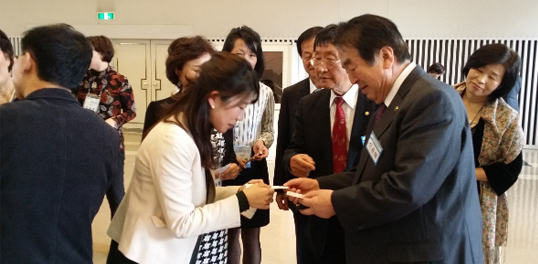
Professor Lee Jong-won of Waseda University Giving Lecture
As for the North Korean-Japanese relations, he commented that “The kidnappings issue is a huge barrier between them and both nations’ interest in talk has fallen so additional progress seems not so easy.”
He finished his lecture by requesting the female participants to “Actively contribute to public diplomacy in order to be a help a diplomatic unification since it is now an era of public diplomacy, where public opinion is important and overseas Koreans are important messengers of civil interchange and mutual understanding.”
After the lectures were the programs participated by the female members.
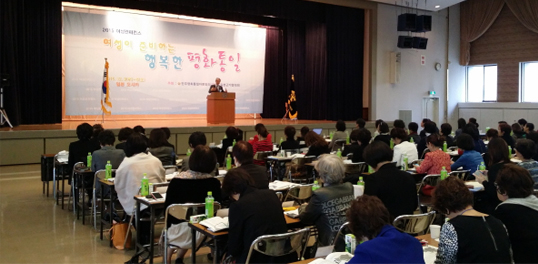
Panelists Carrying Out Q&A Sessions on Unification Talk
First, female Vice-chairperson Kim, Professor Ahn, Attorney Koo and Professor Lee participated as panelists in the “Unification Talk by Women” where they answered questions from the lectures and their thoughts on unification.
The female members asked and expressed around 100 questions and opinions related to unification to which the panelists gave their answers and comments.
Major contents were: unity expenses, possibilities and timing; Jochongnyeon; Korean-Japanese relations; How to teach unification to young adults living overseas; Networking among female members; and Contribution to national unification as women.
Next followed five group discussions.
The discussions were about the Direction of the female members’ (of the municipal chapters and provincial assemblies); activities for unification (centered on ‘Grassroots unification activities’); The references of unification needed in foreign countries and how can they be made; How should Korean women living abroad pursue unification, public diplomacy; and What unification policies do I want to see?
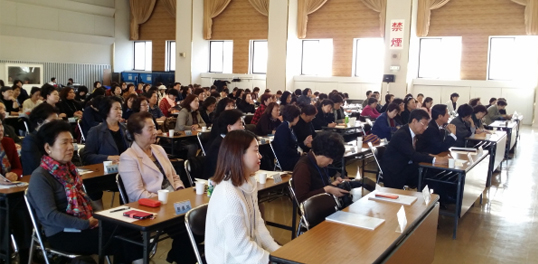
Group Discussion
[Day 3, December 5 (Tues.)]
On Day 3, members presented their discussion results and a general review followed.
The representatives of the five groups participated as panels and the results were presented with Dong Seung-Chul, head of the Overseas Program Division, presiding.
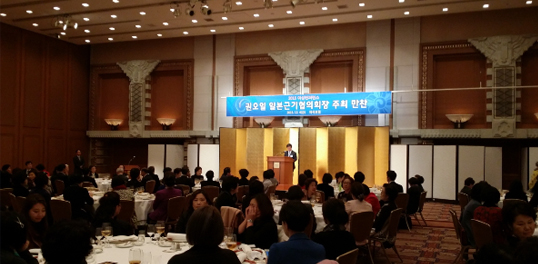
Group Discussion Results Presentation
The conference ended with a presentation, executive members’ comments and singing the unification song.
After the conference, the female members visited Osaka Castle where they expressed their reflected on their time together for three days.
In this conference, the female members from 17 cities and provinces of Asia, Europe, Oceania, Russia, Middle East and Korea attended to broaden the mutual interchange and strengthen their knowledge and will for unification activities. It was particularly valuable because it helped those in Japan who had little opportunities to exchange and meet, network with others, and it helped understand the Japanese brother society better.
